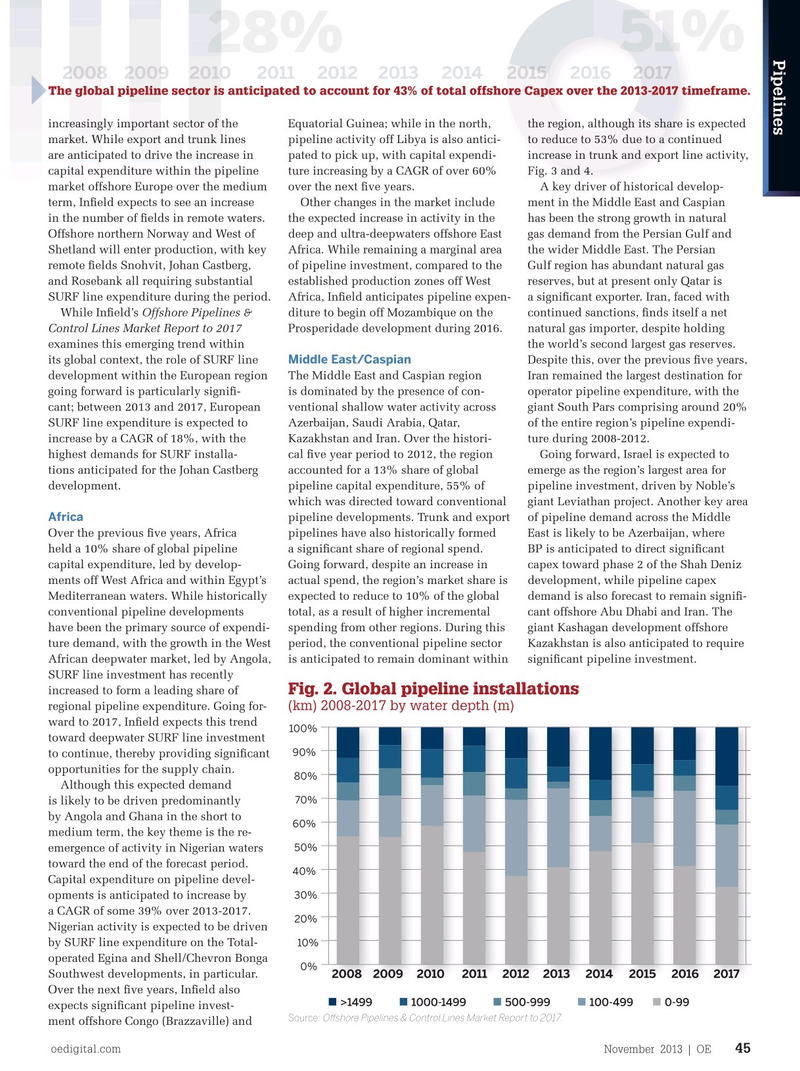
Page 43: of Offshore Engineer Magazine (Nov/Dec 2013)
Read this page in Pdf, Flash or Html5 edition of Nov/Dec 2013 Offshore Engineer Magazine
100% >1499 1000-1499 500-999 100-499 0-99 90% 28% 51% 80%
Pipelines 45% 21% 70% 2008 2009 2010 2011 2012 2013 2014 2015 2016 2017
The global pipeline sector is anticipated to account for 43% of total offshore Capex over the 2013-2017 timeframe.
34% increasingly important sector of the Equatorial Guinea; while in the north, the region, although its share is expected market. While export and trunk lines pipeline activity off Libya is also antici- to reduce to 53% due to a continued are anticipated to drive the increase in pated to pick up, with capital expendi- increase in trunk and export line activity, capital expenditure within the pipeline ture increasing by a CAGR of over 60% Fig. 3 and 4. market offshore Europe over the medium over the next fve years. A key driver of historical develop- term, Infeld expects to see an increase Other changes in the market include ment in the Middle East and Caspian in the number of felds in remote waters. the expected increase in activity in the has been the strong growth in natural
Offshore northern Norway and West of deep and ultra-deepwaters offshore East gas demand from the Persian Gulf and
Shetland will enter production, with key Africa. While remaining a marginal area the wider Middle East. The Persian remote felds Snohvit, Johan Castberg, of pipeline investment, compared to the Gulf region has abundant natural gas and Rosebank all requiring substantial established production zones off West reserves, but at present only Qatar is
SURF line expenditure during the period. Africa, Infeld anticipates pipeline expen- a signifcant exporter. Iran, faced with
While Infeld’s Offshore Pipelines & diture to begin off Mozambique on the continued sanctions, fnds itself a net
Control Lines Market Report to 2017 Prosperidade development during 2016. natural gas importer, despite holding examines this emerging trend within the world’s second largest gas reserves.
Middle East/Caspian its global context, the role of SURF line Despite this, over the previous fve years, development within the European region The Middle East and Caspian region Iran remained the largest destination for going forward is particularly signif- is dominated by the presence of con- operator pipeline expenditure, with the cant; between 2013 and 2017, European ventional shallow water activity across giant South Pars comprising around 20%
SURF line expenditure is expected to Azerbaijan, Saudi Arabia, Qatar, of the entire region’s pipeline expendi- increase by a CAGR of 18%, with the Kazakhstan and Iran. Over the histori- ture during 2008-2012. highest demands for SURF installa- cal fve year period to 2012, the region Going forward, Israel is expected to tions anticipated for the Johan Castberg accounted for a 13% share of global emerge as the region’s largest area for development. pipeline capital expenditure, 55% of pipeline investment, driven by Noble’s which was directed toward conventional giant Leviathan project. Another key area
Africa pipeline developments. Trunk and export of pipeline demand across the Middle
Over the previous fve years, Africa pipelines have also historically formed East is likely to be Azerbaijan, where held a 10% share of global pipeline a signifcant share of regional spend. BP is anticipated to direct signifcant capital expenditure, led by develop- Going forward, despite an increase in capex toward phase 2 of the Shah Deniz ments off West Africa and within Egypt’s actual spend, the region’s market share is development, while pipeline capex
Mediterranean waters. While historically expected to reduce to 10% of the global demand is also forecast to remain signif- conventional pipeline developments total, as a result of higher incremental cant offshore Abu Dhabi and Iran. The have been the primary source of expendi- spending from other regions. During this giant Kashagan development offshore ture demand, with the growth in the West period, the conventional pipeline sector Kazakhstan is also anticipated to require
African deepwater market, led by Angola, is anticipated to remain dominant within signifcant pipeline investment.
SURF line investment has recently increased to form a leading share of
Fig. 2. Global pipeline installations regional pipeline expenditure. Going for- (km) 2008-2017 by water depth (m) ward to 2017, Infeld expects this trend 100% toward deepwater SURF line investment 90% to continue, thereby providing signifcant opportunities for the supply chain. 80%
Although this expected demand 70% is likely to be driven predominantly by Angola and Ghana in the short to 60% medium term, the key theme is the re- 50% emergence of activity in Nigerian waters toward the end of the forecast period. 40%
Capital expenditure on pipeline devel- 30% opments is anticipated to increase by a CAGR of some 39% over 2013-2017. 20%
Nigerian activity is expected to be driven by SURF line expenditure on the Total- 10% operated Egina and Shell/Chevron Bonga 0%
Southwest developments, in particular. 2008 2009 2010 2011 2012 2013 2014 2015 2016 2017 2008 2009 2010 2011 2012 2013 2014 2015 2016 2017
Over the next fve years, Infeld also >1499 1000-1499 500-999 100-499 0-99 expects signifcant pipeline invest-
Source: .Ofshore Pipelines & Control Lines Market Report to 2017 ment offshore Congo (Brazzaville) and oedigital.com November 2013 | OE 45 000_OE1113_Pipelines2.indd 45 10/28/13 1:50 AM

 42
42

 44
44